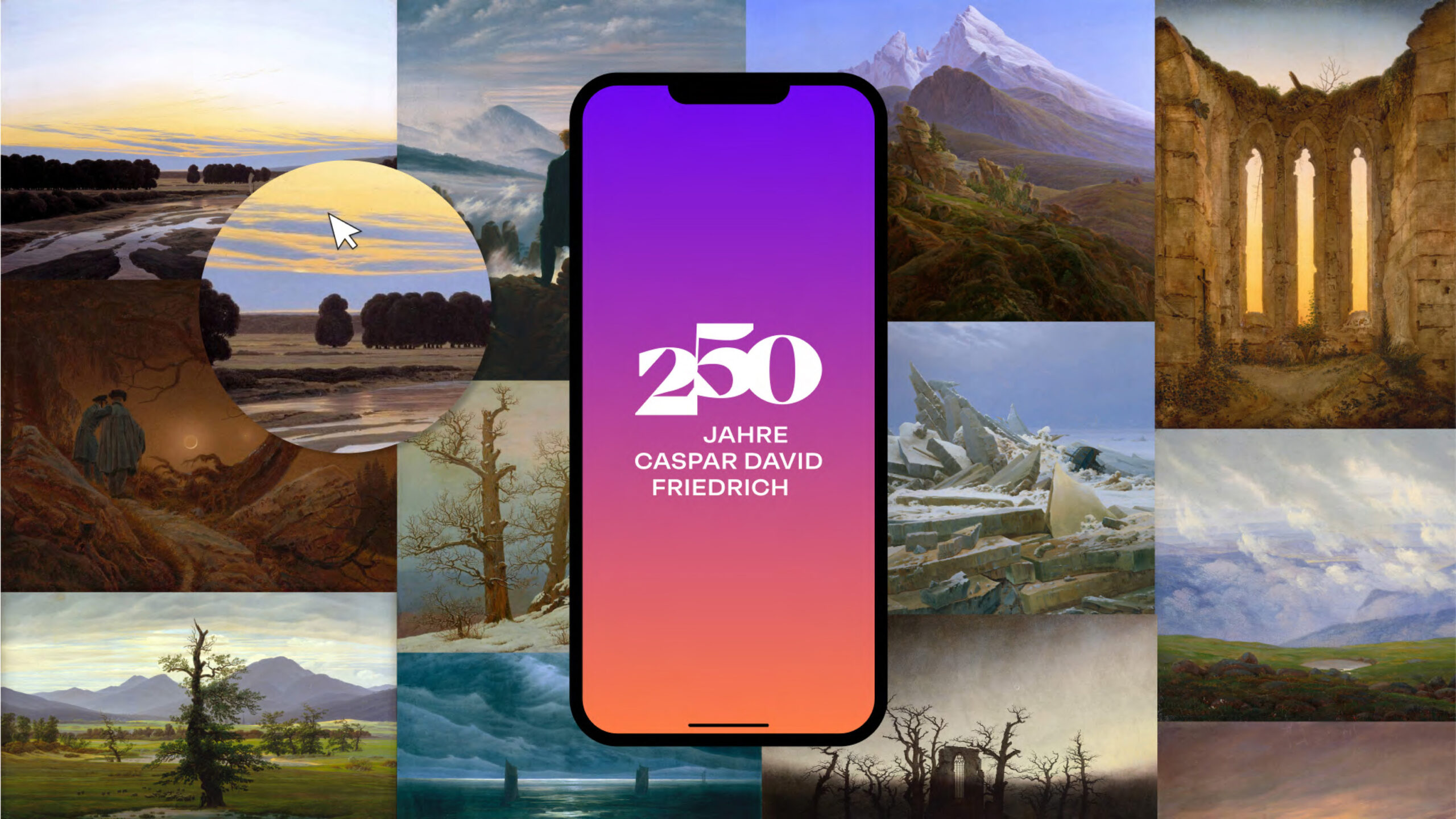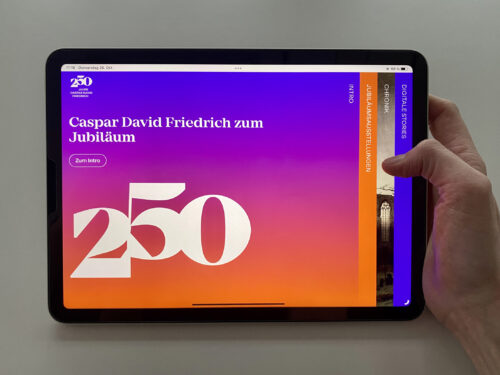Much of the body of work of Romantic painter Caspar David Friedrich can now be viewed on the web portal “cdfriedrich.de”

Hamburg, 02 November 2023
Hamburger Kunsthalle, Alte Nationalgalerie zu Berlin and Staatliche Kunstsammlungen announce: Caspar David Friedrich web portal “cdfriedrich.de” now makes Romantic art comprehensively accessible online. Unique cooperation between museums in Hamburg, Berlin and Dresden as part of the federal government’s digital project “Culture Data Space”.

Around 250 of the works of Caspar David Friedrich (1774–1840) are now available to view on the web portal www.cdfriedrich.de of the most famous German Romantic painter. The portal brings together the artist’s most important paintings and drawings from the collections of the Hamburger Kunsthalle, the Staatliche Museen zu Berlin and the Staatliche Kunstsammlungen Dresden. Some paintings are too fragile to be moved and the drawings are too light-sensitive to be exhibited for any length of time, so the only way to get an overall experience of Friedrich’s oeuvre is in the digital form. To give visitors a greater understanding of Friedrich’s art, the portal proffers different formats: Chronicle gives a broad overview, Shortcuts succinctly explore the themes Friedrich dealt with from today’s perspective and Digital Stories enable users to delve deeply into individual works through the lens of topical issues. This unique cooperation between the museums is happening as part of the digital project “Culture Data Space” as one of a number of flagship projects under the federal government’s digital strategy. The initiative was sparked by the 250th anniversary of the birth of Caspar David Friedrich in 2024 and the three associated anniversary exhibitions in Hamburg, Berlin and Dresden, alongside which “cdfriedrich.de” was created. The portal will continue to evolve throughout the 2024 anniversary year.
At the heart of the web portal is the Chronicle, which gives a comprehensive chronological overview of Friedrich’s oeuvre as well as an insight into his life and times: visitors to the portal can choose to show or hide important events in the artist’s biography and information on what was happening at the time; they can also listen to Friedrich’s words voiced by actor Hanns Zischler. Visitors can instantly obtain listings of more than 500 events, works and statements by the artist depending on their selection – from Highlights to the advanced Expert mode. Viewers can find out more about individual artworks from the detailed texts on upwards of 70 works. The result is a comprehensive view of his oeuvre, supplemented by various expert perspectives on his art.
An entry point into Friedrich’s imagery on the web portal is Shortcuts on subjects such as Who am I?, “Feelings alone tell you what’s beautiful” and Best Friends Forever, which explore Friedrich’s world and work tongue in cheek. Friedrich’s works are well-known and popular yet are not “feelgood” art. They combine fantasy and austerity, misery and hope, subjectivity and universality, precision and openness. They do not provide any answers; rather, they invite questions and also connections to be made with today’s walks of life.
The format Digital Stories goes one step further: it deals with iconic paintings one by one, taking each piece as a starting point for historical and topical questions and theories. The Stories facilitate a deep-dive into the artworks by providing details and background. Digital Stories starts in informative and playful fashion with the work Wanderer above the Sea of Fog, created around 1817. A preliminary sketch for this painting can be dragged over the painting with the mouse; Friedrich takes us with him on his excursions, and a quick quiz reveals why we, the viewers today, travel.
In the anniversary year 2024, a section on the reception his art received in the decades and centuries since his death will be added to Chronicle, which for now focuses on Friedrich’s lifetime from 1774 to 1840. During the preparations for the three exhibitions, further content from the cooperation partners in Hamburg, Berlin and Dresden will be added, including texts and audio files on Friedrich’s key works, further Digital Stories and, in the future, additional multimedia content ranging from gigapixel image to visualisation using art technology tools.
The Culture Data Space
The web portal for the commemoration of the 250th anniversary of the birth of Caspar David Friedrich is a Smart Museum Services use case within the digital project “Culture Data Space”. The “Culture Data Space” (in German) is a joint infrastructure project of acatech – National Academy of Science and Engineering – the Ministry of Culture and Media of the Free and Hanseatic City of Hamburg, the Fraunhofer Institute for Applied Information Technology FIT as well as further partner organisations on a case-by-case basis. The “Culture Data Space” is one of 18 flagship projects in the federal government’s digital strategy. It is fully state-funded by the Beauftragte der Bundesregierung für Kultur und Medien (Federal Government Commissioner for Culture and the Media). Its purpose is to facilitate the creation of a digital network of cultural institutions and the creative industry and the sharing of cultural data with data sovereignty being ensured. The key principle is to protect the data sovereignty of data owners, copyright holders and service providers in the culture, media and creative industries. The idea is that the “Culture Data Space” will make it easier in the future to create offerings similar to the web portal for Caspar David Friedrich. During work on the web portal key requirements and the first prototypes have been and are being identified and described, which will form the basis for developing processes and standards for the “Culture Data Space”.
The artist
Caspar David Friedrich was born in Greifswald on 5 September 1774. He went to Copenhagen to study at the school of visual art and subsequently moved to Dresden. He juxtaposed academic traditions with his own sources of inspiration, which he found in nature; for example, when hiking in the environs of Dresden. He started a family there, and was very successful for a period before his art went out of fashion. More than half a century after his death in 1840, the Centennial Exhibition of German Art in Berlin in 1906 sparked his rediscovery, which saw him celebrated as a forerunner of Modernism. He remains popular today and his art seems particularly relevant, for one, because it embodies the relationship between humankind and nature.
Hamburger Kunsthalle project team: Christian Auffarth, Petra Bassen, Clara Blomeyer and Dr. Katharina Hoins
In cooperation with: Hamburger Kunsthalle, Nationalgalerie der Staatlichen Museen zu Berlin, Staatliche Kunstsammlungen Dresden and Fraunhofer Institute for Applied Information Technology FIT
Funded by:

Further links:


